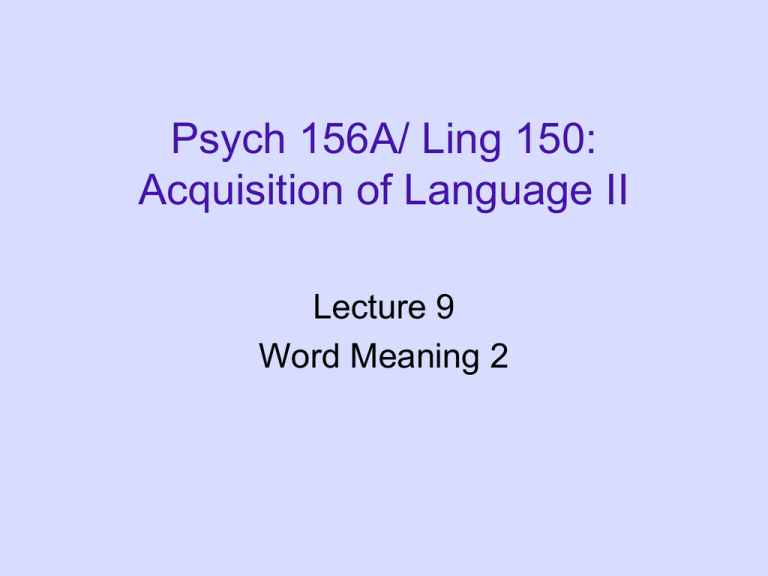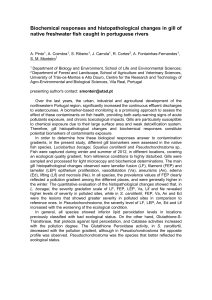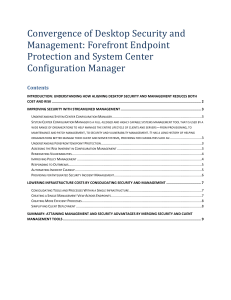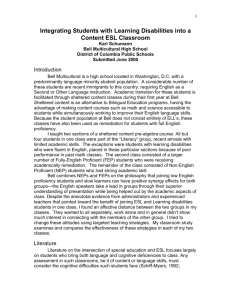pptx
advertisement

Psych 156A/ Ling 150: Acquisition of Language II Lecture 9 Word Meaning 2 Announcements • Pick up HW1 if you haven’t already • Be working on HW2 (due 5/15/12) • In-class midterm review 5/3/12 • Midterm during class 5/8/12 Computational Problem “I love my dax.” Dax = that specific toy, teddy bear, stuffed animal, toy, object, …? What we know about the process of word-learning (1) Word meanings are learned from very few examples. Fastmapping is the extreme case of this, where one exposure is enough for children to infer the correct word-meaning mapping. However, cross-situational learning could work this way too, with a few very informative examples having a big impact. ball bear “Can I have the zib?” kitty 20 months [unknown] What we know about the process of word-learning (2) Word meanings are often inferred from only positive examples. This means that children usually only see examples of what something is, rather than being explicitly told what something is not. “What a cute dax!” “I love my dax.” What we know about the process of word-learning (3) The target of word-learning is a system of overlapping concepts. That is, words pick out different aspects of our world, and it’s often the case that different words can refer to the same observable thing in the world. “I love my teddy.” “He’s my favorite toy.” “He’s brown and cuddly.” What we know about the process of word-learning (3) The target of word-learning is a system of overlapping concepts. That is, words pick out different aspects of our world, and it’s often the case that different words can refer to the same observable thing in the world. Shape vs. material labeling: This is a desk. It’s made of wood. This bookcase is also made of wood. What we know about the process of word-learning (3) The target of word-learning is a system of overlapping concepts. That is, words pick out different aspects of our world, and it’s often the case that different words can refer to the same observable thing in the world. What level of specificity (object-kind labeling)? “This is my labrador, who is a great dog, and a very friendly animal in general.” What we know about the process of word-learning (4) Inferences about word meaning based on examples should be graded, rather than absolute. That is, the child probably still has some uncertainty after learning from the input. This is particularly true if the input is ambiguous (as in cross-situational learning). “I love my dax and my kleeg.” “There are my favorite dax and kleeg!” Some uncertainty remains abut whether “dax” is this or this. Bayesian learning for word-meaning mapping Xu & Tenenbaum (2007: Psychological Review) hypothesize that a child using Bayesian learning would show these behaviors during word learning. Claim: “Learners can rationally infer the meanings of words that label multiple overlapping concepts, from just a few positive examples. Inferences from more ambiguous patterns of data lead to more graded and uncertain patterns of generalization.” The importance of the hypothesis space An important consideration: Bayesian learning can only operate over a defined hypothesis space. Example of a potential hypothesis space for dog: dog = dog parts, front half of dog, dog spots, all spotted things, all running things, all dogs + one cat Two traditional constraints on children’s hypothesis (learning biases): Whole Object constraint: First guess is that a label refers to a whole object, rather than part of the object (dog parts, front half of dog) or an attribute of the object (dog spots) Taxonomic constraint (Markman 1989): First guess about an unknown label is that it applies to the taxonomic class (ex: dog, instead of all running things or all dogs + one cat) Suspicious coincidences & Bayesian learning Situation: fep fep fep fep Suspicious: Why is no other animal or other kind of dog a fep if fep can really label any animal or any kind of dog? Bayesian reasoning: Would expect to see other animals (or dogs) labeled as fep if fep really could mean those things. If fep continues not to be used this way, this is growing support that fep cannot mean those things. Formal instantiation of “suspicious coincidence” Has to do with expectation of the data points that should be encountered in the input More-General (dog) If the more-general generalization (dog) is correct, the learner should encounter some data that can only be accounted for by the more-general generalization (like beagles or poodles). This data would be incompatible with the less-general generalization (dalmatian). Less-general (dalmatian) Formal instantiation of “suspicious coincidence” Has to do with expectation of the data points that should be encountered in the input More-General (dog) If the learner keeps not encountering data compatible only with the more-general generalization, the less-general generalization becomes more and more likely to be the generalization responsible for the language data encountered. Less-general (dalmatian) Formal instantiation of “suspicious coincidence” Another way to think about it: probability of generating data points Suppose there are only 5 dogs in the world that we know about, as shown in this diagram. Hypothesis 1 (H1): The lessgeneral hypothesis is true, and fep means dalmatian. Hypothesis 2 (H2): The moregeneral hypothesis is true, and fep means dog. More-General (dog) Less-general (dalmatian) Formal instantiation of “suspicious coincidence” Another way to think about it: probability of generating data points What’s the likelihood of selecting this dog for each hypothesis? p( | H1) = 1/3 (since only three dogs are possible) p( | H2) = 1/5 (since all five dogs are possible) More-General (dog) Less-general (dalmatian) Formal instantiation of “suspicious coincidence” Another way to think about it: probability of generating data points This means the likelihood for the less-general hypothesis is always going to be larger than the likelihood of the moregeneral hypothesis for data points that both hypotheses can account for. More-General (dog) Less-general (dalmatian) Formal instantiation of “suspicious coincidence” Another way to think about it: probability of generating data points If the prior is equal (ex: before any data, both hypotheses are equally likely), then the posterior probability will be greater for the less-general hypothesis. p(H1 | ) p( | H1) * p(H1) 1/3 * p(H1) p(H2 | ) p( | H2) * p(H2) 1/5 * p(H2) More-General (dog) Less-general (dalmatian) Suspicious coincidences and children Xu & Tenenbaum (2007) wanted to see if children have this kind of response to suspicious coincidences. If so, that means that they make specific generalizations when they encounter data that are compatible with multiple hypotheses about word meaning, in particular: subordinate (least-general), ex: dalmatian basic, ex: dog superordinate (most-general), ex: animal Testing children Subjects: 3- and 4-year-old children Task, part 1: Children were presented with three examples of a novel word (“blick”, “fep”, or “dax”) during training. (“This is a blick/fep/dax”) There were three classes of stimuli: vegetables, vehicles, and animals. The vegetable class had these levels: subordinate: green pepper basic: pepper superordinate: vegetable Testing children Subjects: 3- and 4-year-old children Task, part 1: Children were presented with three examples of a novel word (“blick”, “fep”, or “dax”) during training. (“This is a blick/fep/dax”) There were three classes of stimuli: vegetables, vehicles, and animals. The vehicle class had these levels: subordinate: yellow truck basic: truck superordinate: vehicle Testing children Subjects: 3- and 4-year-old children Task, part 1: Children were presented with three examples of a novel word (“blick”, “fep”, or “dax”) during training. (“This is a blick/fep/dax”) There were three classes of stimuli: vegetables, vehicles, and animals. The animal class had these levels: subordinate: terrier basic: dog superordinate: animal Testing children Subjects: 3- and 4-year-old children Task, part 1: Children were presented with three examples of a novel word (“blick”, “fep”, or “dax”) during training. (“This is a blick/fep/dax”) There were three classes of stimuli: vegetables, vehicles, and animals. There were four conditions: The 1-example condition presented the same object & label three times. Testing children Subjects: 3- and 4-year-old children Task, part 1: Children were presented with three examples of a novel word (“blick”, “fep”, or “dax”) during training. (“This is a blick/fep/dax”) There were three classes of stimuli: vegetables, vehicles, and animals. There were four conditions: The 1-example condition presented the same object & label three times. “This is a fep.” “This is a fep.” “This is a fep.” Testing children Subjects: 3- and 4-year-old children Task, part 1: Children were presented with three examples of a novel word (“blick”, “fep”, or “dax”) during training. (“This is a blick/fep/dax”) There were three classes of stimuli: vegetables, vehicles, and animals. There were four conditions: The 3-subordinate example condition presented a subordinate object & label three times. Testing children Subjects: 3- and 4-year-old children Task, part 1: Children were presented with three examples of a novel word (“blick”, “fep”, or “dax”) during training. (“This is a blick/fep/dax”) There were three classes of stimuli: vegetables, vehicles, and animals. There were four conditions: The 3-subordinate example condition presented a subordinate object & label three times. “This is a fep.” “This is a fep.” “This is a fep.” Testing children Subjects: 3- and 4-year-old children Task, part 1: Children were presented with three examples of a novel word (“blick”, “fep”, or “dax”) during training. (“This is a blick/fep/dax”) There were three classes of stimuli: vegetables, vehicles, and animals. There were four conditions: The 3-basic-level example condition presented a basiclevel object & label three times. Testing children Subjects: 3- and 4-year-old children Task, part 1: Children were presented with three examples of a novel word (“blick”, “fep”, or “dax”) during training. (“This is a blick/fep/dax”) There were three classes of stimuli: vegetables, vehicles, and animals. There were four conditions: The 3-basic-level example condition presented a basiclevel object & label three times. “This is a fep.” “This is a fep.” “This is a fep.” Testing children Subjects: 3- and 4-year-old children Task, part 1: Children were presented with three examples of a novel word (“blick”, “fep”, or “dax”) during training. (“This is a blick/fep/dax”) There were three classes of stimuli: vegetables, vehicles, and animals. There were four conditions: The 3-superordinate example condition presented a superordinate object & label three times. Testing children Subjects: 3- and 4-year-old children Task, part 1: Children were presented with three examples of a novel word (“blick”, “fep”, or “dax”) during training. (“This is a blick/fep/dax”) There were three classes of stimuli: vegetables, vehicles, and animals. There were four conditions: The 3-superordinate example condition presented a superordinate object & label three times. “This is a fep.” “This is a fep.” “This is a fep.” Testing children Subjects: 3- and 4-year-old children Task, part 2: generalization (asked to help Mr.Frog identify only things that are “blicks”/ “feps”/ “daxes” from a set of new objects) There were three kinds of matches available: Subordinate matches (which were the least general, given the examples the children were trained on) Testing children Subjects: 3- and 4-year-old children Task, part 2: generalization (asked to help Mr.Frog identify only things that are “blicks”/ “feps”/ “daxes” from a set of new objects) There were three kinds of matches available: Basic-level matches (which were more general, given the examples the children were trained on) Testing children Subjects: 3- and 4-year-old children Task, part 2: generalization (asked to help Mr.Frog identify only things that are “blicks”/ “feps”/ “daxes” from a set of new objects) There were three kinds of matches available: Superordinate-level matches (which were the most general, given the examples the children were trained on) Children’s generalizations When children heard a single example three times, they readily generalized to the subordinate class, but were less likely to generalize to the basic-level, and even less likely to generalize to the superordinate level. This shows that young children are fairly conservative in their generalization behavior. “This is a fep.” “This is a fep.” “This is a fep.” Children’s generalizations When children had only subordinate examples as input, they readily generalized to the subordinate class, but almost never generalized beyond that. They were sensitive to the suspicious coincidence, and chose the least-general hypothesis compatible with the data. “This is a fep.” “This is a fep.” “This is a fep.” Children’s generalizations When children had basiclevel examples as input, they readily generalized to the subordinate class and the basic-level class, but almost never generalized beyond that. They were again sensitive to the suspicious coincidence, and chose the least-general hypothesis compatible with the data. “This is a fep.” “This is a fep.” “This is a fep.” Children’s generalizations When children had superordinate-level examples as input, they readily generalized to the subordinate class and the basic-level class, and often generalized to the superordinate class. They were again sensitive to the suspicious coincidence, though they were still a little uncertain how far to extend the generalization. “This is a fep.” “This is a fep.” “This is a fep.” Modeling children’s responses Xu & Tenenbaum (2007) found that children’s responses were best captured by a learning model that used Bayesian inference (and so was sensitive to suspicious coincidences). Accounting for other observed behavior How could a child using Bayesian inference make use of evidence like the following: “That’s a dalmatian. It’s a kind of dog.” This explicitly tells children that this object can be labeled as both “dalmatian” and “dog”, and moreover that “dog” is a more general term than “dalmatian”. Accounting for other observed behavior How could a child using Bayesian inference make use of evidence like the following: “That’s a dalmatian. It’s a kind of dog.” A Bayesian learner can treat this as conclusive evidence that dalmatian is a subset of dog and give 0 probability to any hypothesis where dalmatian is not contained within the set of dogs. dog spotted This hypothesis now has 0 probability. Accounting for other observed behavior How could a child using Bayesian inference incorporate lexical contrast, where the meaning of all words must somehow differ? This is particularly important when the child already knows some words like “dog” (ex: “cat”, “puppy”, “pet”) In a Bayesian learner, the prior of hypotheses whose set of referents overlap is lower. Lower prior Known word’s set of referents Higher prior An open question Early word-learning (younger than 3-years-old) appears to be slow & laborious – if children are using Bayesian inference, this shouldn’t be the case. Why would this occur? Potential explanations: (1) Bayesian inference capacity isn’t yet active in early wordlearners. Even though older children (such as the ones tested in Xu & Tenenbaum (2007)) can use this ability, younger children cannot. An open question Early word-learning (younger than 3-years-old) appears to be slow & laborious – if children are using Bayesian inference, this shouldn’t be the case. Why would this occur? Potential explanations: (2) The hypothesis spaces of young children may not be sufficiently constrained to make strong inferences. For example, even though adults know that the set of dogs is much larger than the set of dalmatians, young children may not know this - especially if their family dog is a dalmatian, and they don’t know many other dogs. An open question Early word-learning (younger than 3-years-old) appears to be slow & laborious – if children are using Bayesian inference, this shouldn’t be the case. Why would this occur? Potential explanations: (3) Young children’s ability to remember words and/or their referents isn’t stable. That is, even if someone points out a dalmatian to a child, the child can’t remember the word form or the referent long enough to use that word-meaning mapping as input. (Remember - there’s a lot going on in children’s worlds, and they have limited cognitive resources!) This makes the child’s input much less informative than that same input would be to an adult. Recap Word-learning is difficult because many words refer to concepts that can overlap in the real world. This means that there isn’t just one word for every thing in the world - there are many words, each picking out a different aspect of that thing. Bayesian learning may be a strategy that can help children overcome this difficulty, and experimental evidence suggests that their behavior is consistent with a Bayesian learning strategy. However, Bayesian learning may not be active or help sufficiently at the very earliest stages of word-learning. Questions? Use the remaining time to work on HW2 and the review questions for word meaning. You should be able to do up through question 5 on HW2 and all the review questions.




